Repair and basic malfunctions of fluorescent lamps. Installation of wall-mounted fluorescent fluorescent lamps; photo.
Is it possible to imagine present reality without electric lighting? Wires are broken due to natural disasters and, according to the news, there is information about the number of people left without electricity.
The invention of the light bulb increased the period of human wakefulness by almost 3 hours.
Invention of a bygone century
Lamps daylight ceiling lighting, what applies to this type of lighting, what are their positive properties that attract attention, and are they in demand not only here, but also in the world? What are the significant or insignificant shortcomings?
Can I install them myself? Will the price suit you and should you save on it?
We will try to understand these issues so that readers have a clear understanding and make their choice. The photo above shows lamps familiar from childhood.
Not all fluorescent lamps are and can be called fluorescent lamps. Daylight is created in fluorescent lamps ah with a temperature of 4200 K and above.
Ceiling fluorescent lamps do not have a spiral, but the temperature is indicated in the list of technical characteristics.
The color emitted by the lamp depends on it; the lower the temperature, the redder the color:
- The letter K - indicates the value on the Kelvin scale;
- Ceiling fluorescent lamps differ from gas-discharge lamps in the formation of a light source;
- Secondary radiation, and not a discharge, is created by the phosphor. Ultraviolet radiation, invisible to the eye, interacts with the coating and visible light appears;
- If the surface were not covered with phosphor, then it would simply be a lamp for heating with ultraviolet light;
- The ballast is responsible for turning on, continuous power and no flickering;
- The amount of phosphor affects the quality of objects illuminated by fluorescent lamps.
Have you noticed the color of meat under such lamps?
Attention: The light output of long lamps with higher power is higher; it is more economical to use two 36-watt lamps for lighting than four 18-watt lamps.
Variety of forms and contents
Science does not stand still, and long tubes of daylight have been transformed into compact lamps that are screwed into an ordinary socket. have daylight different purposes and dimensions.
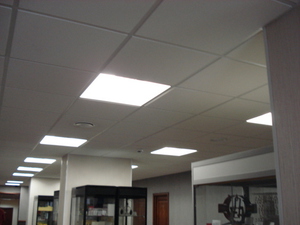
Advantages and properties that have become attractive to consumers:
- Significant reduction in energy consumption and, accordingly, billing costs by up to 80% compared to incandescent lamps;
- A ten-year or even more service life, directly depending on the installation location and the number of inclusions;
- Used in small, compact luminaires:
- Stable light intensity and high-quality light output;
- Heats up to 60° C., which eliminates ignition and fire;
- The ability to choose a color to your liking, either warm, natural, or daytime;
- The simplicity of their installation is captivating, so you can easily and quickly connect yourself;
- A variety of shapes - ring-shaped, “U”-shaped, tube-shaped, straight, linear
A ceiling fluorescent lamp, like any electrical appliance, has its drawbacks:
- Voltage fluctuations, turning the lamp on and off causes an acute reaction and reduces service life;
- Protecting the eyes with a lampshade from stray light is mandatory;
- The temperature should be +5°C and above, at low temperatures the lamps burn dimly;
- The lamp does not light up instantly; it takes some time to gain power.
Note: A 5-20 watt fluorescent lamp is the same as a 25-100 watt incandescent lamp. When installing them, the cost of paying for electricity is reduced and the service life of the lamp is increased.
Brief overview of lamps
Daylight has found its own design application in office lighting. For lighting rooms in which there is not enough daylight, or too much light and natural light interferes with computer work.
Blinds cover the windows, and a daylight ceiling light is turned on in the office:
- Lighting in the office plays a primary role in the organization of work;
- Poor lighting affects your well-being because your eyes get tired quickly and your blood pressure may increase;
- The mood changes, the ability to concentrate on the main thing;
- Labor productivity decreases;
- To indicators successful work The company receives the profit they receive, and it depends on the cost of production, where one of the items is payment for electricity consumption, installing fluorescent lamps is one of the ways to solve the problem of paying for electricity;
- High efficiency in energy consumption has become a determining argument in the selection of data and industrial buildings;
- They are manufactured with mirror grilles, with plastic diffusers, reflected light lamps, with different protective degrees, surface-mounted lamps and recessed lamps, with a choke and electronic ballasts.

Ceiling fluorescent lamps are widely used for lighting large industrial premises, hangars, trading floors, exhibition centers, entertainment venues, subways, and educational institutions. Design and aesthetics are present in planning the placement of lamps, but they are not in the first place; there are slightly different criteria and requirements.

- Compliance with technical and sanitary standards illumination;
- Worker safety;
- Reliability and efficiency;
- High mechanical strength;
- Vibration resistance;
- Wear resistance.
These components are the determining factors when installing lighting fixtures in the above rooms.
Attention: The current power of fluorescent lamps reaches from 15 to 100 watts. They are recognized as the most effective due to their similarity to natural light.
Ceiling fluorescent lamp in household premises also found its use. Incorrectly selected and installed lamps, the power and direction of their radiation can nullify good repair, or they can highlight all the advantages and hide the shortcomings of the room.
Modern lamps are radically different from lamps with fluorescent lamps, but ten years ago.
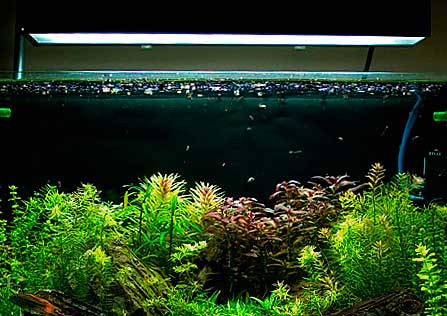
- Maximum comfort of lighting and psychological unification of everyone present in the room is ensured;
- Absent Negative influence on vision;
- Quiet operation;
- Can also be used in small rooms;
- The corridor is decorated with a chandelier with daylight, and an additional lamp will be reflected in the mirror;
- There is also a chandelier in the kitchen, but with a dedicated beam of light above the work area;
- Illumination of plants and aquariums;
- Creation decorative effects and many other areas of application of this wonderful invention.
Various aspects of the use of luminaires with fluorescent lamps are covered in the presented material. It is recommended to watch the video; price plays an important role in choosing a lamp and room.
Ready-made instructions that this is good, but this is not necessary, will never be written, and it is not necessary. Everyone has a choice.
Good luck in choosing the style of the premises, lighting - classic, modern, floristry. The next article will be devoted specifically to them - modern lamps.
The main criteria for choosing a lighting source are its efficiency, relatively low cost and long service life. In this regard, great popularity in Lately purchased fluorescent lamps or so-called fluorescent lamps.
Advantages and disadvantages of fluorescent lamps
Their main advantage is a fairly high coefficient useful action, which is 5 times greater than the identical indicator of an incandescent lamp. The service life of a fluorescent lamp with satisfactory power supply quality and limited number of on/off switches can be up to 20 thousand hours. Fluorescent fixtures can provide diffuse illumination and depending on use various types light bulbs provide different shades of light. They do not overheat, so they are often used in various designs with limited air volume and movement without the risk of fire.
Fluorescent lamps in a suspended ceiling
The main disadvantage of this type of light bulb is the risk of chemical contamination if the glass bulb of the light bulb is damaged. It should also be taken into account that fluorescent lighting sources react strongly to temperature environment. Maximum light output is observed at a temperature of +18-25. When the temperature drops, the power luminous flux decreases, but if the surrounding air has a temperature below +5, the likelihood that the lighting device may not turn on at all increases significantly.
Characteristics of the color spectrum of fluorescent lamps
The operation of a fluorescent lamp is based on the phenomenon of an arc discharge between the electrodes, which are located at opposite ends of the bulb bulb. After current passes through an inert gas and mercury vapor, filling the glass lamp body under a certain pressure, a ultraviolet radiation. The transformation of ultraviolet radiation, invisible to the human eye, occurs by coating the inner walls of the flask with a phosphor. This substance capable of absorbing ultraviolet radiation, transforming it into normal visible to man radiation.
The use of various components in the manufacturing process of the phosphor gives a variety of shades of lamp glow: soft or cool shade white light, daylight, etc. Each shade is suitable for a specific application. Cool shades and daylight are more suitable for office and production premises, public buildings. Softer shades of white are best for living spaces.
The color of a light bulb can be determined by an indicator such as color temperature. If the glow temperature is within 2700K, the light bulb will glow with soft white light. At a temperature of 4200K and above, the lamp will produce daylight, and at 6400K and above a cool bluish tint will appear. When choosing a light source, remember that the higher the glow temperature, the more the color spectrum of the lamp shifts from red to blue.

Colorful temperature
Color rendering and color temperature markings
To choose the right lighting source, you must first pay attention to the labeling. The international format for marking fluorescent light bulbs consists of three numbers. The first number indicates the color rendering index value. The higher the index, the more reliable the colors look in the light of a light bulb. The next two numbers indicate the color temperature (42-4200, 64-6400, etc.).
A high level of color rendering is important in museum and exhibition halls, in educational institutions, administrative and office premises where accurate color reproduction is required. In residential premises, production workshops, enterprises Catering and sales areas can be used ceiling lamps with a lower color rendering level.
Domestic producers other markings are used, the designations of which look as follows:
- LB - used to designate fluorescent lamps with a white glow;
- LD – stands for fluorescent lamps;
- LHB - indicates a cold shade of white light;
- LTB – light bulb with warm shade white light;
- LE – natural shade of glow;
- LTB is the same natural glow, only with a cold tint.
The letter C added to any of these designations indicates improved color rendering, while a double C indicates the use of high-quality color rendering.
In addition to fluorescent lamps general purpose There are also special lamps that have special spectral characteristics. These include lighting sources with high color rendering quality and a glow temperature of 5400K, used as ceiling lighting in dental offices, art galleries and publishing houses. In basements, storage rooms and other rooms with limited access sunlight, special lamps are used, the illumination of which is similar to sunlight. Such light sources have high color rendering and a color temperature of at least 6400K.
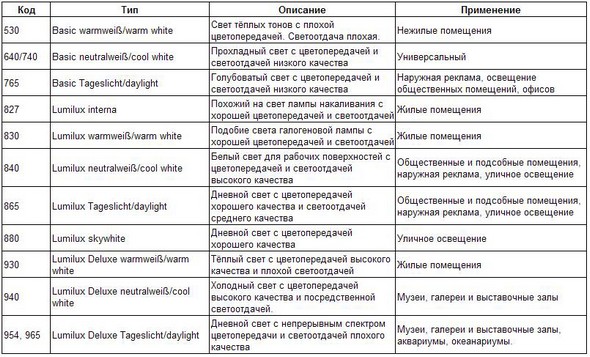
International markings for color rendering and color temperature
Choosing the power of ceiling lamps
One of the parameters that you should pay attention to when choosing a fluorescent ceiling light is the power of the lamp. Today, general purpose lamps are available with powers ranging from 5W to 80W. For compact LLs this figure can vary from 5 to 30 W, for linear ones - from 15 to 80 W. The power of a linear light source depends on its length: LLs with a length of 45 cm have the smallest indicator, and those with a bulb length of 1.5 m have the highest.
In the case when conventional incandescent lamps are replaced with more economical fluorescent lamps, their power should be 5 times less. So, if an incandescent light bulb with a power of 150 W was sufficient in the room, then it can be replaced with a daylight LL with a power rating of 30 W.
To ensure sufficient ceiling lighting In small residential and industrial premises, it is enough to use compact lamps. For lighting rooms with a large area and high ceilings, it is necessary to use linear lamps with higher power.
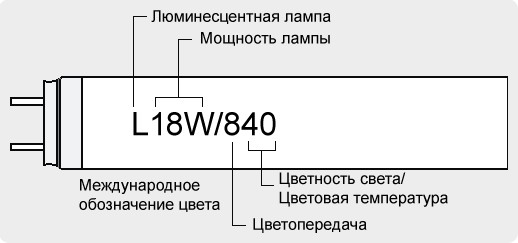
LL encoding
Choosing the shape of daylight LL
Fluorescent fluorescent lamps have a fairly wide range, and differ various options execution.
Compact fluorescent light bulbs can be used as a replacement for conventional incandescent light bulbs in ceiling chandeliers and fixtures. When choosing a compact lamp, first of all you need to pay attention to the type of base, which must match the socket in the lamp. You should also remember that compact LLs are much larger than incandescent lamps, and if chosen incorrectly, they may not fit into the lampshade. Compact fluorescent lamps are also used in ceiling spotlights for installation suspended ceilings.
Linear LLs can be used in both single and modular multi-lamp ceiling lamps. Due to the high power of linear lamps, such lighting used for lighting industrial premises large area, shopping areas, public buildings.
Fluorescent lamps LPO are used: for schools, educational institutions, kindergartens, lighting public premises, clinics/hospitals, industrial warehouses (dry), office buildings/premises, entrances of residential buildings (housing and communal services), car services, utility rooms. They have a degree of protection IP20.
Difference between lamps:
- 2x36(40) - two lamps with a power of 36(40) watts, length 1200 mm.
- 1x36(40) - one lamp with a power of 36(40) watts, length 1200 mm.
- 2x18(20) - two lamps with a power of 18(20) watts, length 600 mm.
- 1x18(20) - one lamp with a power of 18(20) watts, length 600 mm.
LPO lamps are general-purpose fluorescent lamps for lighting public spaces that work with fluorescent lamps. Luminescent overhead lamps, both ceiling and wall. Surface-mounted lamps are attached using two to four screws or self-tapping screws through the housing to the ceiling or wall. Metal base. The diffuser of the lamps is both transparent and matte. Luminaires for fluorescent lamps have two lengths, 600 mm with a lamp of 18 (20) watts and 1200 mm which use lamps with a power of 36 (40) watts and are available at each power with both one lamp and two lamps.
Fluorescent wall lamps use fluorescent lamps with a T8 bulb tube and a power of 18 watts and 36 watts.
There are two types of fluorescent lamps: electronic (with an electronic ballast starter) and with a choke + starter (electronic ballast)
All lamps operate from a mains voltage of 220 volts.
Ceiling fluorescent lamps LPO have a degree of protection IP20 (not sealed) and can only be used in dry rooms or under a roof (canopy), to avoid direct contact with water and snow.
Fluorescent fluorescent lamps LPO price is indicated without lamps.
You can order fluorescent lamps 2x36, buy or find out prices on our website or by calling.
Fluorescent lamps LPO, price does not include lamps.
Fluorescent ceiling lamps are designed for lighting public spaces, educational institutions, hospitals, schools, kindergartens, shops, offices.
Fluorescent lamps (or fluorescent lamps) are lighting devices made on the basis of gas, phosphor and mercury.
As a result of the interaction of the components under the influence of electricity passing through the cathodes built into the base of the element, ultraviolet radiation is formed, which is converted into light.
This method of converting electricity into light is quite effective and economical, so fluorescent lamps have taken an important place in modern life. A large luminous surface, a wide color spectrum, a variety of shapes and sizes make possible use them for lighting both domestic and industrial facilities.
A fluorescent lamp or fluorescent lamp is a sealed glass tube filled with a mixture of argon and mercury under low or high pressure. Luminosity occurs when an electrical discharge passes through mercury vapor, creating an ultraviolet glow. Inner surface tube processed thin layer phosphor substances.
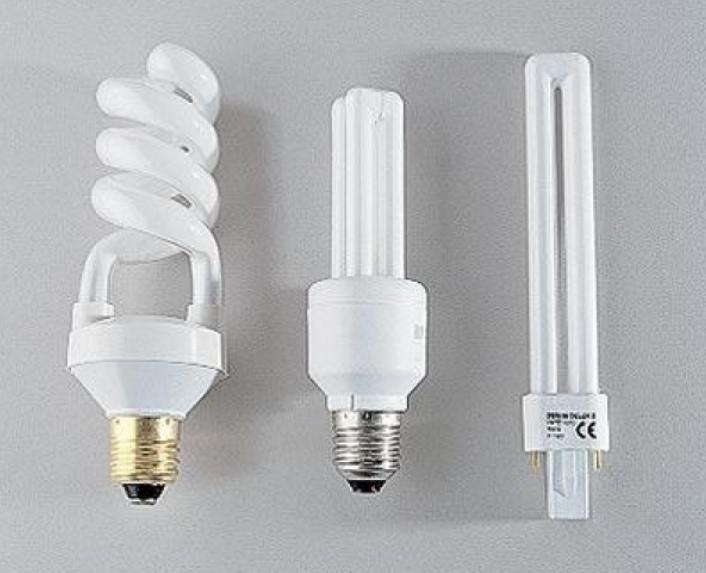 Fluorescent lamps
Fluorescent lamps Under its influence, the ultraviolet glow turns into light perceived by the eye. The lamps are turned on using a choke - a special electromagnetic ballast or ballast.
Lamps with electronic ballasts have the best specifications in comparison with the throttle ballast.
There are two types of fluorescent lamps:
- linear- glass tubes of various diameters and with different types base;
- compact- have a curved bulb shape and can be screwed into a threaded cartridge or with an adapter.
Lamps that use single-layer phosphors are of the standard type. The light in these lamps is of different shades of white. They are mainly used for lighting large industrial and commercial areas.
When using three to five layers of phosphor, fluorescent lamps are classified as an enhanced color rendering type. The luminosity of these lamps is approximately 12% higher than standard fluorescent lamps, which allows them to be used for clearer lighting. Can be installed in museums, galleries and other similar places.
Lamps with spectral characteristics from 5400K to 6700K, having various additives and colored bulbs are classified as special luminescent lamps. They have a wide range of applications. They are used in medicine, in sterile industries, for aquariums and many other areas.
Specifications
| Emission color | Color quality | Design features | Lamp power, W/ bulb length with base, mm | Diameter in inches (mm) | Compact lamp base type |
|---|---|---|---|---|---|
| L - luminescent | R - reflex | 15 /450 | T4 - 4/8 (12.7) | 2D | |
| TL - glow discharge | C - improved color quality | R - reflex | 15 /450 | T4 - 4/8 (12.7) | 2D |
| D - daytime | CC - color rendering of particularly high quality | U-shaped | 18 /600 | T5 - 5/8 (15.9) | G 23 |
| HB - cold - white | CC | K - ring | 30 /900 | T8 - 8/8 (25.4) | G 27 |
| B - white | CC | A - amalgam | 36 /1200 | T10 - 10/8 (31.7) | G 24, G 24Q1, G 24Q2, G 24Q3 |
| TB - warm - white | CC | B - quick start | 40 /1200 | T12 - 12/8 (38.0) | G53 |
| E - naturally white | CC | B - quick start | 58 /1500 | T12 - 12/8 (38.0) | E27 |
| L - luminescent | CC | B - quick start | 80 /1500 | T12 - 12/8 (38.0) | E14, E40 |
 Marking energy saving light bulbs
Marking energy saving light bulbs 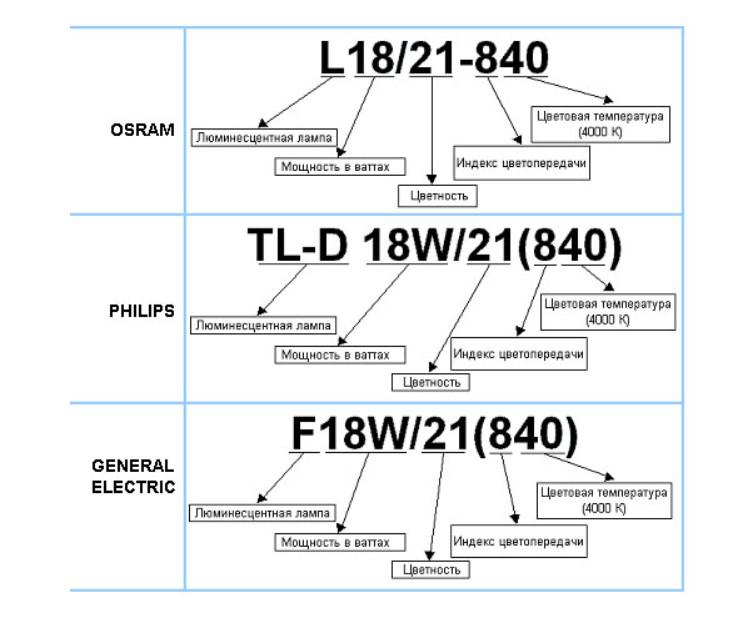 Decoding the markings on a fluorescent lamp
Decoding the markings on a fluorescent lamp Also There are lamps with yellow, green, cyan, blue and ultraviolet(not visible to the human eye) colors of radiation.
Based on the luminous temperature range, fluorescent lamps are divided into the following categories:
The positive characteristics include the following properties fluorescent lamps:
- good luminosity and efficiency is 20% higher than that of a simple one tungsten lamp incandescent;
- wide range of light shades;
- uniform lighting distribution;
- lamp heating no more than 600C;
- long service life (2000 -20000 hours), at air temperatures from 5 to 350C and compliance with switching restrictions.
The disadvantages of fluorescent lamps are characterized by the following indicators:
When fluorescent lamps fail, disposal requirements must be followed to avoid mercury leakage.
Scope of application
Ceiling lamps with fluorescent lamps can be divided according to their purpose:
- industrial– for lighting production areas;
- office- designed for lighting work rooms;
- household– used for home lighting.
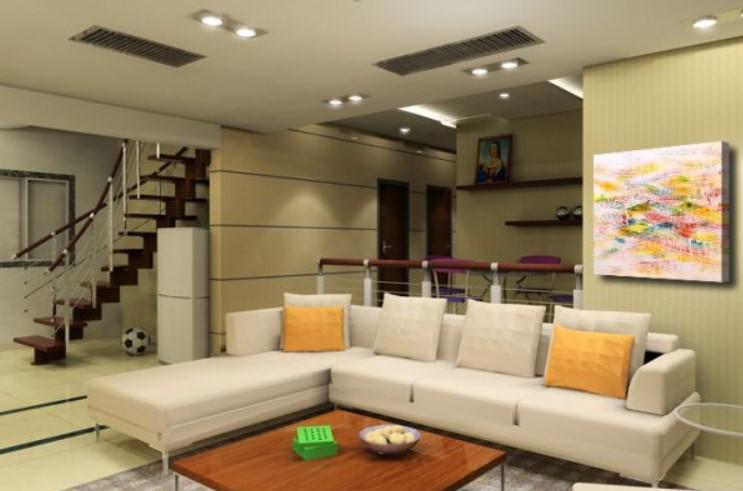 Ceiling lamp in the interior
Ceiling lamp in the interior High quality lighting industrial premises improves labor productivity and ensures the safety of the production cycle. The use of industrial lighting helps reduce energy consumption and improve lighting levels in production.
The following requirements apply to industrial luminaires:
- high efficiency;
- ease of installation and maintenance;
- protection against pollution;
- compactness, light weight;
- long service life.
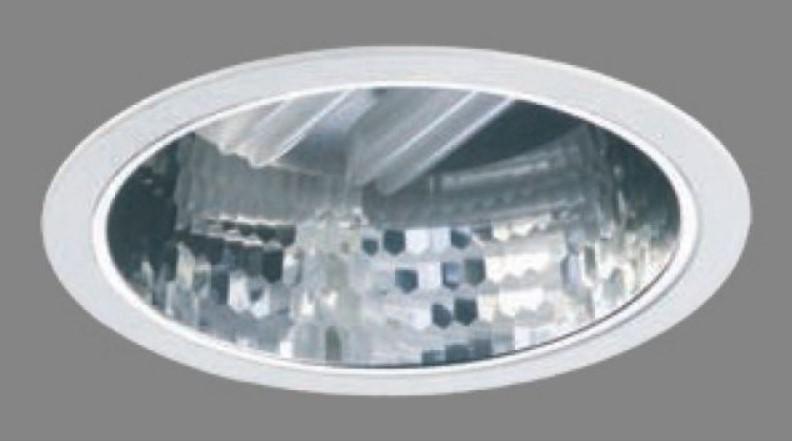 CFL spot ceiling light
CFL spot ceiling light  Modern industrial fluorescent luminaires
Modern industrial fluorescent luminaires 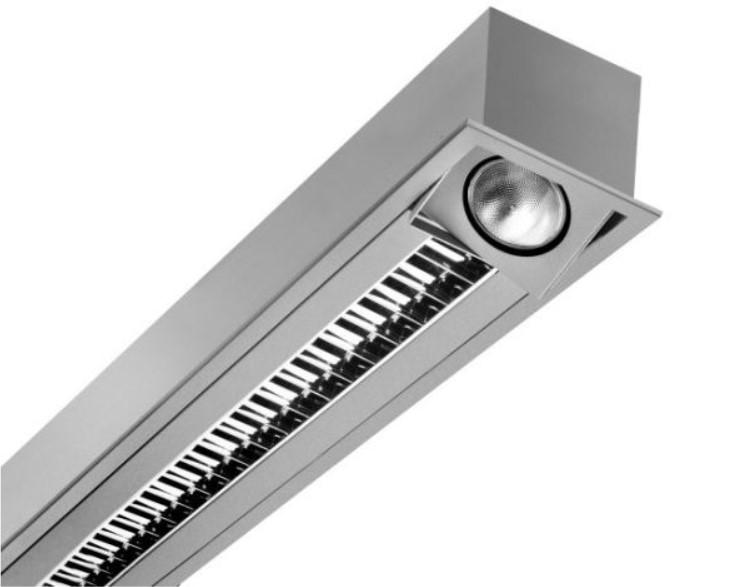 Commercial luminaires with energy saving lamps
Commercial luminaires with energy saving lamps Types of luminaires for industrial lighting:
- ceiling spotlights;
- track models;
- LED directional light devices.
The most common source of lighting for the home is luminaires with fluorescent lamps, attached different ways on the ceiling. They are divided into:
- built-in- installed in various types of suspended ceiling structures;
- mortise- for suspended ceilings and suspended plasterboard structures;
- invoices- installation takes place directly on the ceiling.
Recessed rectangular household luminaires with fluorescent lamps are used to illuminate the entire area of the room. Designed for installation of 4 to 8 lamps, they have ballasts, reflective and light-scattering elements. The delivery set includes a variety of reflectors.
Lamps are:
- classic or parabolic mirror;
- oval;
- prismatic.
Spots are elongated rectangular lighting sources. There are various geometric shapes.
Reflector types:
- scattering (reflecting) light;
- mirrored;
- matted.
When choosing lamps for your home, you should take into account the required lighting intensity and color spectrum.
Ceiling lamps
Protective shades or diffusers protect fluorescent lamps from damage. Modern models are made of impact-resistant materials, equipped with ballasts and built-in batteries. They also serve to diffuse the light flux and protect lamps from various contaminants.
Price
The cost of fluorescent lamps with fluorescent lamps has a very wide range. The following types can be considered the most popular:
- spotlights or recessed ceiling lights. The most affordable lighting system. The price of one lamp starts from 150 rubles;
- spots - universal ceiling lamps can be purchased from 2000 rubles;
- The track system will cost from 6,000 rubles.
There are also more expensive products well-known companies, the price of which is from 30,000 to 100,000 rubles.
Compact lamps
A compact fluorescent lamp is a lighting device whose electronic trigger control is built into the lamp base. Available with standard sockets E27 and E14, which makes it possible to use such a lamp in ordinary chandeliers and lamps. It has all the advantages and disadvantages of a simple low-pressure gas-filled lamp.
Designed for a voltage of 220 V, while energy consumption is 5 times less than lamps with tungsten filament. Provide excellent luminous flux and have 8 times longer service life.
If a lamp in a cramped lampshade overheats, there is a risk of the plastic socket melting, the light emission also becomes less intense and the brightness decreases.
Pros and cons of artificial “daylight” for skin, eye and nervous system health
Fluorescent lamps have some advantages over conventional incandescent lamps:
- increased light output;
- low surface brightness;
- the spectrum of emitted light is close to natural;
- less heat radiation.
They appear when lighting spacious rooms, where many lighting installations are used to create a normal level of illumination.
The disadvantages of fluorescent lamps include their specific feature - micropulsation of the light flux. This negatively affects not only a person’s vision, causing additional stress on the eyes, but also affects the nervous system.
Micropulsation causes increased fatigue and irritability. Also, the presence of mercury in the lamp increases the risk of harm to the body if the bulb is damaged.
The flickering and buzzing sound occurs when the starter tries to ignite a damaged lamp.
To learn how fluorescent lamps are made and whether you can get burned under their light, watch the video:
They allow the use of products with maximum benefit for the family budget, are highly efficient, have sufficient power with low energy consumption and have a wide range of applications. The main disadvantage is the presence of mercury inside the lamp, which, if improperly disposed of or handled carelessly, can cause certain harm to health.
Nowadays, lamps with fluorescent lamps are a fairly common phenomenon throughout the world. What advantages and disadvantages they have, and whether such lamps with fluorescent lamps can be installed independently - let’s find out in this material.
Fluorescent lamps for the ceiling: main features
The most famous fluorescent ceiling lights are devices equipped with fluorescent lamps. However, it is a mistake to believe that all such devices can be fluorescent lamps. This is only possible for fluorescent lamps having a temperature of more than 4200 degrees Kelvin. Also, fluorescent lamps mounted on the ceiling are not equipped with a spiral.
Key Features ceiling lamps in fluorescent lamps:

Pros and cons of these lamps
Lamps of this type differ from each other in their size and purpose. Regardless of size and properties, they have their pros and cons. Among the advantages of lamps equipped with devices daylighting, the following points can be highlighted:
- significant energy savings of approximately 80 percent compared to the use of incandescent lamps;
- depending on the installation location and the number of on/off switches, such lighting devices can be used for more than ten years;
- the possibility of using daylighting devices in compact luminaires;
- high-quality and stable light output, constant light intensity;
- fire resistance;
- a wide range of color solutions for instruments;
- ease of installation;
- wide choose tube shapes: they can be in the form of rings, tubes, rectangles or oblong lines.
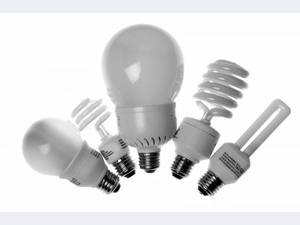
But along with positive characteristics fluorescent lamps also have their disadvantages, including:
- the presence of voltage drops, reduced service life due to frequent switching on and off;
- the inability to use the lamp without special protective capes or means, for example, a matte lampshade;
- the possibility of comfortable operation of lighting devices only at above-zero temperatures;
- The process of ignition of the structure does not occur instantly, but gradually, gaining power.
As mentioned earlier, these lighting structures may have different shapes. The wattage and diameter of tubular lamps are not related to each other. Thus, tube-shaped lamps with a diameter of 16 to 60 mm can have a power of up to 200 watts.
Fluorescent daylight fixtures are equipped with tubes that can change the length of the product while maintaining its original power.
If you want to independently change the incandescent lamp in your lamp to a fluorescent one, then remove old light bulb, and screw the new one through a threaded chuck or install it using an adapter. Lamp sockets are threaded and have 2-4 pins, and a two-pin lamp also includes a starter. But a lamp equipped with four pins can also work with an electronic ballast.
Fluorescent lamps have different purposes - they are lighting devices for small lamps, and large structures for ceiling mounting.
Advantages of using fluorescent lamps in office and industrial premises
Ceiling fluorescent lamps have traditionally been used in offices for decades. They are very convenient, because often there is not enough daylight for employees to work comfortably, and conventional lighting fixtures are too bright and interfere with normal work at computers. This is why fluorescent lamps are most often turned on in offices when closed blinds windows.
The main reasons for using fluorescent lamps in offices:
- lighting has a direct impact on the quality of work of employees;
- Due to poor lighting, employees damage their vision and get tired faster:
- at poor lighting it is more difficult to concentrate on work and productivity decreases;
- incandescent lamps affect electricity bills, and this is an extra expense for company managers.
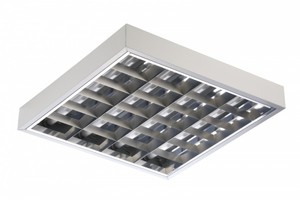 Also, similar devices are actively used by large industrial premises. And this applies not only to warehouses and factories, but also to exhibition institutions, shopping centers, metro station lobbies, hangars, educational institutions with large space and other types of large premises.
Also, similar devices are actively used by large industrial premises. And this applies not only to warehouses and factories, but also to exhibition institutions, shopping centers, metro station lobbies, hangars, educational institutions with large space and other types of large premises.
Advantages of equipping ceilings in large rooms fluorescent lamps are quite obvious:
- daylighting devices comply with all sanitary and technical standards on room lighting;
- good lighting ensures the safety of workers of large manufacturing enterprises;
- such devices are reliable and economical;
- they have high level strength;
- Fluorescent lamps are wear-resistant and resistant to all kinds of vibrations.
The use of fluorescent lamps in residential premises
 Ceiling lamps and chandeliers equipped with such lamps are increasingly being used not only in commercial premises, but also in residential buildings and apartments. They have become stylish and compact, capable of emphasizing the elements of the style of a particular room in your apartment or country house.
Ceiling lamps and chandeliers equipped with such lamps are increasingly being used not only in commercial premises, but also in residential buildings and apartments. They have become stylish and compact, capable of emphasizing the elements of the style of a particular room in your apartment or country house.
At the same time, it is necessary to be able to choose the right fluorescent lamps, since an incorrectly selected model and power that does not correspond to the room can ruin the entire ambiance. But correctly selected devices will perfectly hide the shortcomings in the room and emphasize its advantages. When purchasing a fluorescent lamp for your home, pay attention to power, price, dimensions and shape. Yes, you can pick different variants daylight for a particular room in your home.
So, in the living room the most appropriate option would be to place ceiling chandelier on fluorescent lamps, it will make the light in the room saturated and visually bring those present in the room closer to each other. This is especially true for those who often have guests at home.
For the dining room, it is best to use lighting fixtures that provide a combined type of lighting, when part of the radiation goes towards the floor, and part towards the ceiling.
In the bedroom, you can install chandeliers with fluorescent lamps, allowing you to softly diffuse light along the room and create a relaxing effect. But in a children's room, the light should be bright and uniform, but it is better to cover the lamp with a matte shade.
 In the hallway and kitchen, fluorescent lamps can be supplemented with local light sources for the mirror in the hallway and working area in the kitchen.
In the hallway and kitchen, fluorescent lamps can be supplemented with local light sources for the mirror in the hallway and working area in the kitchen.
The bathroom will appear larger if you install a fluorescent lamp built into the ceiling. Lighting can be supplemented with small spotlight lamps to accentuate a particular area of the room.




